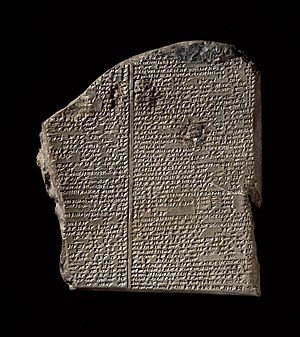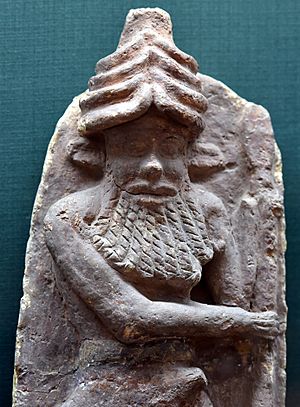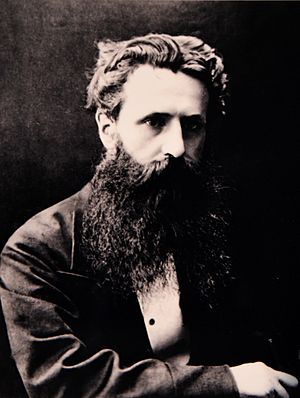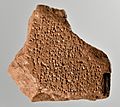Epic of Gilgamesh facts for kids
The Epic of Gilgamesh is a very old and famous story from ancient Mesopotamia. It's like one of the first adventure books ever written! The most complete version we have was found on twelve clay tablets. These tablets were kept in the library of King Ashurbanipal of Assyria around 700 BC.

The story is about a legendary hero-king named Gilgamesh. It was probably put together from older Sumerian tales. These tales were written in the Akkadian language. Today, many people still read the Epic of Gilgamesh. Gilgamesh himself has become a popular character in books and movies.
Contents
Discovering the Epic of Gilgamesh

Around the 1850s, many pieces of ancient clay tablets were found. These were discovered in the Library of Ashurbanipal in Nineveh. Important archaeologists like Austen Henry Layard helped find them. Later, a scholar named George Smith studied these fragments. In 1872, he shared his amazing discovery. He had translated parts of the story.
From all the pieces found, two main versions of the epic have been put back together. One is called the Standard Babylonian version. Its title means "He who saw the deep." The other is the Old Babylonian version. Its title means "Surpassing all other kings." There were also five older Sumerian poems about Gilgamesh. Some of these had early versions of parts of the Babylonian story. Others told completely different tales.
How the Epic Was Translated
The first direct translation into Arabic came out in the 1960s. It was done by an Iraqi archaeologist named Taha Baqir.
A very important modern translation was made by Andrew R. George. It was published in 2003. Many experts believe his work is the most important in 70 years. George explained the condition of the surviving tablets. He also provided a translation side-by-side with the original language.
In 2004, Stephen Mitchell released a version. It was a bit different because it took some freedoms with the text. It also included modern ideas and comments. In 2021, another translation by Sophus Helle was published.
The Story of Gilgamesh's Adventures

The first part of the story is about Gilgamesh, the king of Uruk. He was a very strong but sometimes unfair ruler. The gods created a wild man named Enkidu to stop Gilgamesh. Enkidu came to Uruk and challenged Gilgamesh. Gilgamesh won their fight, but they became great friends.
Together, Gilgamesh and Enkidu went on a long journey. They traveled to the famous Cedar Forest. There, they planned to defeat the Guardian, Humbaba the Terrible. They also wanted to cut down the sacred Cedar tree. After their adventures, the goddess Ishtar sent the Bull of Heaven to punish Gilgamesh. Gilgamesh and Enkidu killed the Bull of Heaven. Because of this, the gods decided to punish Enkidu with death.
In the second part of the epic, Gilgamesh is very sad about Enkidu's death. He decides to go on a dangerous journey. He wants to find the secret to living forever. Eventually, he learns an important lesson. He finds out that humans cannot escape death. The gods made death a part of human life.
Even though he didn't find eternal life, Gilgamesh became very famous. This was because of his big building projects. Also, the wise advice he received and the story of the Great Flood helped his fame grow. The Epic of Gilgamesh is now translated into many languages. It is also featured in many popular stories and movies.
This epic is seen as a very important work. It helped shape ideas about religion and heroic stories. Gilgamesh is like an early version of later heroes. For example, he is similar to Heracles (Hercules). The epic itself also influenced other famous stories, like the Homeric epics.
Connections to the Bible
The Epic of Gilgamesh has several ideas and parts that are similar to the Hebrew Bible. For example, there are connections to the story of the Garden of Eden. There are also similarities to advice found in Ecclesiastes. Most notably, there are strong links to the Genesis flood narrative.
Many characters in the Epic have mythical parallels in the Bible. One example is Ninti, a Sumerian goddess of life. She was created from the rib of the god Enki to heal him. This happened after he ate forbidden flowers. Some people think this story might have influenced the story of Eve. In the Book of Genesis, Eve is created from Adam's rib.
See also
 In Spanish: Poema de Gilgamesh para niños
In Spanish: Poema de Gilgamesh para niños
- List of artifacts in biblical archaeology
- List of characters in Epic of Gilgamesh
- Babylonian literature
- Cattle in religion
- Sumerian creation myth
- Sumerian literature
Images for kids
-
The second dream of Gilgamesh on the journey to the Forest of Cedar. Epic of Gilgamesh tablet from Hattusa, Turkey. 13th century BCE. Neues Museum, Germany






